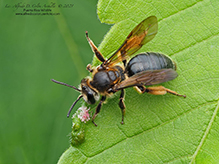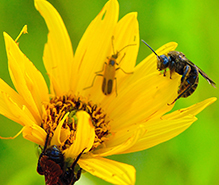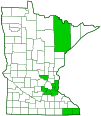Giant sweat bee
(Dieunomia heteropoda)
Conservation • Description • Habitat • Ecology • Distribution • Taxonomy
Conservation Status |
|||
| IUCN Red List | not listed |
||
| NatureServe | NNR - Unranked SNR - Unranked |
||
| Minnesota | not listed |
||
Description
Giant sweat bee is a medium-sized to large, dark, solitary, ground-nesting bee. It occurs in the southern two-thirds of the United States and in northern Mexico. There are two recognized subspecies of giant sweat bee. Dieunomia heteropoda ssp. kirbii, the southern subspecies, is a large bee, and is the source of the common name. Dieunomia heteropoda ssp. heteropoda), the northern subspecies, is a medium-sized bee. Only the northern subspecies occurs in Minnesota. It was first collected in Minnesota in 1824 in Scott County.
The male is ⅝″ (17 mm) in length.
The head is black and shiny. The face is rounded. There is a single line-like groove extending downward from the base of each antenna (subantennal suture). The tongue is short. The antennae on the female have 12 segments, on the male they have 13 segments. The last antennal segment on the male is broad and flattened.
The thorax is shiny black, coarsely punctured (pitted), and densely covered with hairs.
The abdomen is black, shiny, and densely punctured. At the end of each abdominal segment (tergite) there is a band of brown or light brown hairs. On the last tergite the band does not appear divided. When viewed from above, the first tergite is shallowly indented and has a shallow V-shaped groove on the front margin. The sides of each tergite have a tuft of pollen-collecting hairs. The tufts often wrap to the upper side.
The wings are tinted brown. On the forewing there are three submarginal cells. The basal vein on the forewing is strongly curved (arced) inward.
The legs are black. On the middle legs the third segment (femur) is greatly swollen. The fourth segment (tibia) has no spurs at the end. On the hind legs the femur is swollen but not as much as on the middle leg. On the male the tibia has a large, flattened, triangular extension on the inside. There are two spurs on the extension. The last part of the leg (tarsus), corresponding to the foot, has five segments. The first segment on the hind leg is greatly elongated and has a fringe of hairs on the inside.
Size
Female Length: 9⁄16″ (14 mm)
Male Length: ⅝″ (17 mm)
Similar Species
Habitat
Prairies, corn and soybean crops
Ecology
Season
July through mid-September
Behavior
Life Cycle
Giant sweat bee is a solitary nester. The female builds a nest in the ground surrounded by a giant mound of excavated soil. The opening to the nest is at the base of the mound. While each nest is occupied by a single female, there are often many nests in a small area..
Larva Food/Hosts
Adult Food
Pollen and nectar of mostly prairie sunflower (Helianthus petiolaris) but also other sunflowers
Distribution |
||
|
Sources |
|
| 10/8/2025 | ||
Occurrence |
||
|
||
Taxonomy
Order
Hymenoptera (Ants, Bees, Wasps, and Sawflies)
Suborder
Apocrita (Narrow-waisted Wasps, Ants, and Bees)
Infraorder
Aculeata (Ants, Bees, and Stinging Wasps)
Superfamily
Apoidea (Bees and Apoid Wasps)
Epifamily
Family
Halictidae (sweat bees)
Subfamily
Nomiinae
Genus
Dieunomia
Subgenus
Dieunomia
Subordinate Taxa
giant sweat bee (Dieunomia heteropoda ssp. kirbii) ![]()
giant sweat bee (Dieunomia heteropoda ssp. heteropoda) ![]()
![]()
Synonyms
Nomia heteropoda
Common Names
giant sweat bee
sunflower sweat bee
Glossary
Femur
On insects and arachnids, the third, largest, most robust segment of the leg, coming immediately before the tibia. On humans, the thigh bone.
Tibia
The fourth segment of an insect leg, after the femur and before the tarsus (foot). The fifth segment of a spider leg or palp. Plural: tibiae.
Visitor Photos
Share your photo of this insect.
This button not working for you?
Simply email us at info@MinnesotaSeasons.com.
Attach one or more photos and, if you like, a caption.
Alfredo Colon |
 |
Scott Leddy |
 |
MinnesotaSeasons.com Photos
|

Slideshows
Dieunomia heteropoda
USGS Bee Inventory and Monitoring Lab

Visitor Videos
Share your video of this insect.
This button not working for you?
Simply email us at info@MinnesotaSeasons.com.
Attach a video, a YouTube link, or a cloud storage link.
Other Videos

Visitor Sightings
Report a sighting of this insect.
This button not working for you?
Simply email us at info@MinnesotaSeasons.com.
Be sure to include a location.
MinnesotaSeasons.com Sightings



